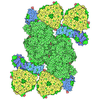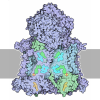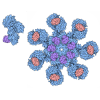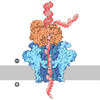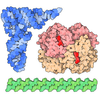[English] 日本語
 Yorodumi
Yorodumi- PDB-9eh5: Structure of a mutated photosystem II complex reveals changes to ... -
+ Open data
Open data
- Basic information
Basic information
| Entry | Database: PDB / ID: 9eh5 | ||||||
|---|---|---|---|---|---|---|---|
| Title | Structure of a mutated photosystem II complex reveals changes to the hydrogen-bonding network that affect proton egress during O-O bond formation | ||||||
 Components Components |
| ||||||
 Keywords Keywords | PHOTOSYNTHESIS / photosystem II / oxygen-evolving complex / transition metals / metalloenzyme / mutagenesis / water channel / hydrogen-bond network | ||||||
| Function / homology |  Function and homology information Function and homology informationplasma membrane-derived thylakoid photosystem II / photosystem II oxygen evolving complex / photosystem II assembly / oxygen evolving activity / photosystem II stabilization / photosystem II reaction center / photosystem II / oxidoreductase activity, acting on diphenols and related substances as donors, oxygen as acceptor / photosynthetic electron transport chain / photosystem II ...plasma membrane-derived thylakoid photosystem II / photosystem II oxygen evolving complex / photosystem II assembly / oxygen evolving activity / photosystem II stabilization / photosystem II reaction center / photosystem II / oxidoreductase activity, acting on diphenols and related substances as donors, oxygen as acceptor / photosynthetic electron transport chain / photosystem II / response to herbicide / extrinsic component of membrane / chlorophyll binding / plasma membrane-derived thylakoid membrane / photosynthetic electron transport in photosystem II / : / phosphate ion binding / photosynthesis, light reaction / photosynthesis / respiratory electron transport chain / manganese ion binding / electron transfer activity / protein stabilization / iron ion binding / heme binding / calcium ion binding / metal ion binding / identical protein binding Similarity search - Function | ||||||
| Biological species |  | ||||||
| Method | ELECTRON MICROSCOPY / single particle reconstruction / cryo EM / Resolution: 1.97 Å | ||||||
 Authors Authors | Flesher, D.A. / Shin, J. / Debus, R.J. / Brudvig, G.W. | ||||||
| Funding support |  United States, 1items United States, 1items
| ||||||
 Citation Citation |  Journal: J Biol Chem / Year: 2025 Journal: J Biol Chem / Year: 2025Title: Structure of a mutated photosystem II complex reveals changes to the hydrogen-bonding network that affect proton egress during O-O bond formation. Authors: David A Flesher / Jieun Shin / Richard J Debus / Gary W Brudvig /  Abstract: Photosystem II (PSII) is the water-splitting enzyme of oxygenic photosynthesis. Using light energy, PSII catalytically oxidizes two water molecules to fuel downstream metabolism, forming an O-O bond ...Photosystem II (PSII) is the water-splitting enzyme of oxygenic photosynthesis. Using light energy, PSII catalytically oxidizes two water molecules to fuel downstream metabolism, forming an O-O bond and releasing O as a byproduct. The reaction mechanism requires the strategic removal of four protons via conserved hydrogen-bonding networks, but these pathways remain poorly understood. Site-directed mutagenesis has been used to study these pathways and the role of specific side chains, such as Lys317 of the D2 subunit. Previous studies showed that the D2-Lys317Ala substitution, which abolishes the flexible hydrogen-bonding -NH group, resulted in delayed O release kinetics and diminished catalytic turnover, suggesting Lys317 has a crucial role in facilitating proton egress. Here, we investigated this proton egress pathway by determining the cryo-EM structure of PSII containing the D2-Lys317Ala substitution at a resolution of 1.97 Å. We observed that four new water molecules fill the space previously occupied by Lys317, but these waters lack specific water-protein interactions, leading to heterogeneity and suboptimal hydrogen bonding. We hypothesize that these waters negatively contribute to the existing hydrogen-bonding network and increase the entropic barrier for proton transfer. Additionally, we observed that a conserved chloride ion (Cl1), which is associated with Lys317, is unexpectedly maintained in D2-Lys317Ala PSII. However, unlike in wild-type, Cl1 has no measured effect on oxygen-evolution rates in D2-Lys317Ala PSII. This suggests that the role of Cl1 is dependent on the Lys317 amino group. These findings provide new insight into proton egress through the Cl1 hydrogen-bonding channel. | ||||||
| History |
|
- Structure visualization
Structure visualization
| Structure viewer | Molecule:  Molmil Molmil Jmol/JSmol Jmol/JSmol |
|---|
- Downloads & links
Downloads & links
- Download
Download
| PDBx/mmCIF format |  9eh5.cif.gz 9eh5.cif.gz | 1.3 MB | Display |  PDBx/mmCIF format PDBx/mmCIF format |
|---|---|---|---|---|
| PDB format |  pdb9eh5.ent.gz pdb9eh5.ent.gz | 1.1 MB | Display |  PDB format PDB format |
| PDBx/mmJSON format |  9eh5.json.gz 9eh5.json.gz | Tree view |  PDBx/mmJSON format PDBx/mmJSON format | |
| Others |  Other downloads Other downloads |
-Validation report
| Arichive directory |  https://data.pdbj.org/pub/pdb/validation_reports/eh/9eh5 https://data.pdbj.org/pub/pdb/validation_reports/eh/9eh5 ftp://data.pdbj.org/pub/pdb/validation_reports/eh/9eh5 ftp://data.pdbj.org/pub/pdb/validation_reports/eh/9eh5 | HTTPS FTP |
|---|
-Related structure data
| Related structure data |  48046MC M: map data used to model this data C: citing same article ( |
|---|---|
| Similar structure data | Similarity search - Function & homology  F&H Search F&H Search |
- Links
Links
- Assembly
Assembly
| Deposited unit | 
|
|---|---|
| 1 |
|
- Components
Components
-Photosystem II ... , 17 types, 34 molecules AaBbCcDdHhIiJjKkLlMmOoRrTtUuXx...
| #1: Protein | Mass: 38280.531 Da / Num. of mol.: 2 / Source method: isolated from a natural source / Source: (natural)  #2: Protein | Mass: 55954.355 Da / Num. of mol.: 2 / Source method: isolated from a natural source / Source: (natural)  #3: Protein | Mass: 50344.723 Da / Num. of mol.: 2 / Source method: isolated from a natural source / Source: (natural)  #4: Protein | Mass: 39461.137 Da / Num. of mol.: 2 / Source method: isolated from a natural source / Source: (natural)  #7: Protein | Mass: 7120.404 Da / Num. of mol.: 2 / Source method: isolated from a natural source / Source: (natural)  #8: Protein/peptide | Mass: 4338.119 Da / Num. of mol.: 2 / Source method: isolated from a natural source / Source: (natural)  #9: Protein/peptide | Mass: 3976.687 Da / Num. of mol.: 2 / Source method: isolated from a natural source / Source: (natural)  #10: Protein/peptide | Mass: 5114.127 Da / Num. of mol.: 2 / Source method: isolated from a natural source / Source: (natural)  #11: Protein/peptide | Mass: 4476.145 Da / Num. of mol.: 2 / Source method: isolated from a natural source / Source: (natural)  #12: Protein/peptide | Mass: 3910.639 Da / Num. of mol.: 2 / Source method: isolated from a natural source / Source: (natural)  #13: Protein | Mass: 29939.584 Da / Num. of mol.: 2 / Source method: isolated from a natural source / Source: (natural)  #15: Protein/peptide | Mass: 4204.958 Da / Num. of mol.: 2 / Source method: isolated from a natural source / Source: (natural)  #16: Protein/peptide | Mass: 3571.318 Da / Num. of mol.: 2 / Source method: isolated from a natural source / Source: (natural)  #17: Protein | Mass: 14256.163 Da / Num. of mol.: 2 / Source method: isolated from a natural source / Source: (natural)  #19: Protein/peptide | Mass: 4189.036 Da / Num. of mol.: 2 / Source method: isolated from a natural source / Source: (natural)  #20: Protein/peptide | Mass: 4143.993 Da / Num. of mol.: 2 / Source method: isolated from a natural source / Source: (natural)  #21: Protein | Mass: 6736.161 Da / Num. of mol.: 2 / Source method: isolated from a natural source / Source: (natural)  |
|---|
-Cytochrome b559 subunit ... , 2 types, 4 molecules EeFf
| #5: Protein | Mass: 9454.577 Da / Num. of mol.: 2 / Source method: isolated from a natural source / Source: (natural)  #6: Protein/peptide | Mass: 4935.784 Da / Num. of mol.: 2 / Source method: isolated from a natural source / Source: (natural)  |
|---|
-Protein , 2 types, 4 molecules QqVv
| #14: Protein | Mass: 16494.934 Da / Num. of mol.: 2 / Source method: isolated from a natural source / Source: (natural)  #18: Protein | Mass: 17901.045 Da / Num. of mol.: 2 / Source method: isolated from a natural source / Source: (natural)  |
|---|
-Sugars , 2 types, 74 molecules 
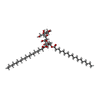

| #31: Sugar | ChemComp-LMT / #34: Sugar | ChemComp-DGD / |
|---|
-Non-polymers , 15 types, 1456 molecules 
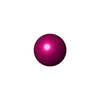




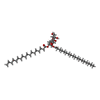
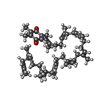
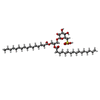
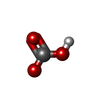
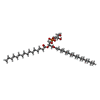


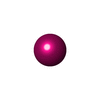
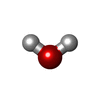














| #22: Chemical | | #23: Chemical | #24: Chemical | ChemComp-CL / #25: Chemical | ChemComp-CLA / #26: Chemical | ChemComp-PHO / #27: Chemical | ChemComp-BCR / #28: Chemical | ChemComp-LMG / #29: Chemical | ChemComp-PL9 / #30: Chemical | ChemComp-SQD / #32: Chemical | #33: Chemical | ChemComp-LHG / #35: Chemical | ChemComp-HEM / #36: Chemical | #37: Chemical | ChemComp-CA / #38: Water | ChemComp-HOH / | |
|---|
-Details
| Has ligand of interest | Y |
|---|---|
| Has protein modification | Y |
| Sequence details | The sequence for chains A and a end at ALA 344. The C-terminal end is removed by a post- ...The sequence for chains A and a end at ALA 344. The C-terminal end is removed by a post-translational process that remoes the sequence SGEQAPVALT |
-Experimental details
-Experiment
| Experiment | Method: ELECTRON MICROSCOPY |
|---|---|
| EM experiment | Aggregation state: PARTICLE / 3D reconstruction method: single particle reconstruction |
- Sample preparation
Sample preparation
| Component | Name: photosystem II / Type: COMPLEX / Entity ID: #1-#21 / Source: NATURAL |
|---|---|
| Source (natural) | Organism:  |
| Buffer solution | pH: 6.8 |
| Specimen | Embedding applied: NO / Shadowing applied: NO / Staining applied: NO / Vitrification applied: YES |
| Vitrification | Cryogen name: ETHANE |
- Electron microscopy imaging
Electron microscopy imaging
| Experimental equipment |  Model: Titan Krios / Image courtesy: FEI Company |
|---|---|
| Microscopy | Model: TFS KRIOS |
| Electron gun | Electron source:  FIELD EMISSION GUN / Accelerating voltage: 300 kV / Illumination mode: FLOOD BEAM FIELD EMISSION GUN / Accelerating voltage: 300 kV / Illumination mode: FLOOD BEAM |
| Electron lens | Mode: BRIGHT FIELD / Nominal defocus max: 2000 nm / Nominal defocus min: 1000 nm |
| Image recording | Electron dose: 38 e/Å2 / Film or detector model: GATAN K3 (6k x 4k) |
- Processing
Processing
| CTF correction | Type: PHASE FLIPPING AND AMPLITUDE CORRECTION |
|---|---|
| 3D reconstruction | Resolution: 1.97 Å / Resolution method: FSC 0.143 CUT-OFF / Num. of particles: 518876 / Symmetry type: POINT |
 Movie
Movie Controller
Controller


 PDBj
PDBj